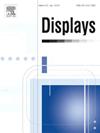MWPRFN: Multilevel Wavelet Pyramid Recurrent Fusion Network for underwater image enhancement
IF 3.4
2区 工程技术
Q1 COMPUTER SCIENCE, HARDWARE & ARCHITECTURE
引用次数: 0
Abstract
Underwater images often suffer from color distortion, blurry details, and low contrast due to light scattering and water-type changes. Existing methods mainly focus on spatial information and ignore frequency-difference processing, which hinders the solution to the mixing degradation problem. To overcome these challenges, we propose a multi-scale wavelet pyramid recurrent fusion network (MWPRFN). This network retains low-frequency features at all levels, integrates them into a low-frequency enhancement branch, and fuses image features using a multi-scale dynamic cross-layer mechanism (DCLM) to capture the correlation between high and low frequencies. Each stage of the multi-level framework consists of a multi-frequency information interaction pyramid network (MFIPN) and an atmospheric light compensation estimation network (ALCEN). The low-frequency branch of the MFIPN enhances global details through an efficient context refinement module (ECRM). In contrast, the high-frequency branch extracts texture and edge features through a multi-scale difference expansion module (MSDC). After the inverse wavelet transform, ALCEN uses atmospheric light estimation and frequency domain compensation to compensate for color distortion. Experimental results show that MWPRFN significantly improves the quality of underwater images on five benchmark datasets. Compared with state-of-the-art methods, objective image quality metrics including PSNR, SSIM, and NIQE are improved by an average of 3.45%, 1.32%, and 4.50% respectively. Specifically, PSNR increased from 24.03 decibels to 24.86 decibels, SSIM increased from 0.9002 to 0.9121, and NIQE decreased from 3.261 to 3.115.
多层小波金字塔递归融合网络用于水下图像增强
由于光散射和水类型的变化,水下图像经常遭受色彩失真、细节模糊和对比度低的困扰。现有方法主要关注空间信息,忽略频差处理,阻碍了混频退化问题的解决。为了克服这些挑战,我们提出了一种多尺度小波金字塔递归融合网络(MWPRFN)。该网络保留了所有级别的低频特征,并将其整合到低频增强分支中,并使用多尺度动态跨层机制(DCLM)融合图像特征以捕获高低频之间的相关性。多层框架的每一阶段由多频信息交互金字塔网络(MFIPN)和大气光补偿估计网络(ALCEN)组成。MFIPN的低频分支通过高效的上下文细化模块(ECRM)增强全局细节。高频分支通过多尺度差分扩展模块(MSDC)提取纹理和边缘特征。在小波反变换后,ALCEN采用大气光估计和频域补偿来补偿颜色失真。实验结果表明,MWPRFN在5个基准数据集上显著提高了水下图像的质量。与最先进的方法相比,客观图像质量指标(包括PSNR, SSIM和NIQE)平均分别提高了3.45%,1.32%和4.50%。具体来说,PSNR从24.03分贝上升到24.86分贝,SSIM从0.9002上升到0.9121,NIQE从3.261下降到3.115。
本文章由计算机程序翻译,如有差异,请以英文原文为准。
求助全文
约1分钟内获得全文
求助全文
来源期刊

Displays
工程技术-工程:电子与电气
CiteScore
4.60
自引率
25.60%
发文量
138
审稿时长
92 days
期刊介绍:
Displays is the international journal covering the research and development of display technology, its effective presentation and perception of information, and applications and systems including display-human interface.
Technical papers on practical developments in Displays technology provide an effective channel to promote greater understanding and cross-fertilization across the diverse disciplines of the Displays community. Original research papers solving ergonomics issues at the display-human interface advance effective presentation of information. Tutorial papers covering fundamentals intended for display technologies and human factor engineers new to the field will also occasionally featured.
 求助内容:
求助内容: 应助结果提醒方式:
应助结果提醒方式:


